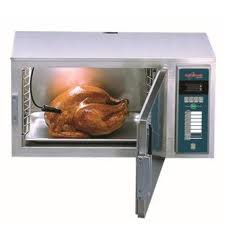The cook-and-hold oven, or "retherm oven" as it's sometimes nicknamed, is an excellent option for preparation of convenience meals. Schools and hospitals use it to reheat large quantities of frozen, prepared dishes-ravioli, macaroni and cheese, dishes made with sauces or gravies-and maintain them hot until they are served. The cook-and-hold benefit is its low, steady temperature, which heats a product without having drying it out or burning it. Exactly where large quantities of roasted meats are consumed, cook-and-hold capability is also a should. Radiant and convection heat combine to make meals gradually while keeping shrinkage to a minimum. When the cooking cycle is finished, the oven's preset timer switches it to some holding mode that keeps the food warm. Holding is actually recommended-for beef roasts, for instance-because enzymes within the meat provide their personal organic tenderizing procedure as the finished roast sits for a minimum of 90 minutes right after cooking. You will find 3 fundamental kinds of cook-and-maintain foods production:
1 . A single type of oven uses natural convection (no air movement), cooks at a slightly greater heat, and maintains a humidity level of 90 to 95 %.
2 . Another roasts at slightly lower temperatures having a slow-moving air present and humidity levels of 30 to 60 percent.
3. A third option may be the "smoke-and-hold" oven, which can cold-smoke (i. e., smoke at low temperatures), then gradually roast something from salmon, to tomatoes, to hazelnuts.
A normal cook-and-hold could be converted to some smoke-and-hold with a firebox attachment (which permits the oven to burn wood and charcoal) and an ash collection tray. Smoke-and-hold ovens have slightly higher electric energy requirements. They also require exhaust hoods, which aren't needed otherwise. Additionally to becoming nicely suited to high-volume cooking, cook-and-hold ovens are power effective simply because, even though cooking times are longer, temperatures are reduced and require much less total energy than conventional ovens. Some food service businesses do their slow-cooking overnight, because they're safe and low-temperature enough to become left unattended. The heat range to get a cook-and-hold oven is from 140 to 245 degrees Fahrenheit; 140 degrees Fahrenheit is the lowest safe holding temperature that prevents dangerous bacteria from multiplying. Some ovens have timers (as much as 100 hours of roasting time could be programmed) or use electric meat probes to determine when items are done.
Either way, the oven automatically returns to its holding temperature when prompted. If a programmed oven experiences a big temperature change, it'll trigger a warning beeper and/or caution light. Tabletop ovens can be ordered having a carving station on top, for use in buffet lines. Simply because they cook so gradually, meats in a cook-and-hold oven ought to be placed on wire racks so they'll brown uniformly; a sheet pan can be placed on the oven deck to catch any drippings. The power requirements of cook-and-hold ovens range from 120-volt single phase to 380-volt three phase. No special ventilation is needed, so the ovens can be rolled on 5-inch casters. The capacity to get a single cook-and-hold oven is about 90 pounds of item; stacked double ovens can hold as much as 180 pounds.













0 comments:
Post a Comment